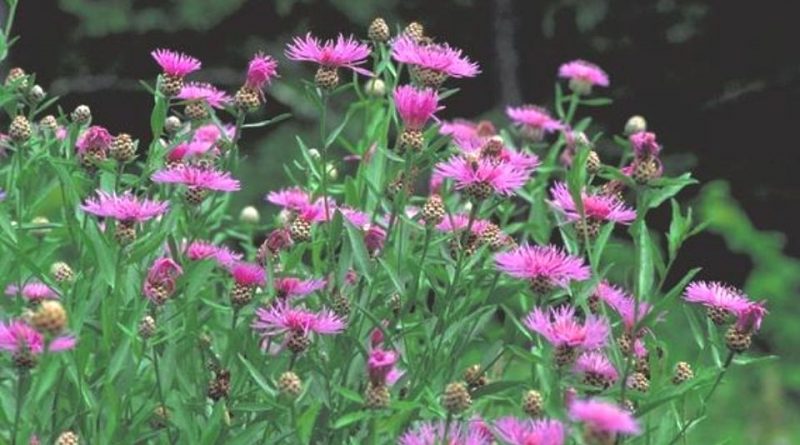Centaurea jacea
Centaurea jacea
The Brown Knapweed (Centaurea jacea L., 1753) is a perennial herbaceous species, belonging to the Asteraceae family.
Systematics –
From the systematic point of view it belongs to the Eukaryota Domain, Kingdom Plantae, Spermatophyta Superdivision, Magnoliophyta Division, Magnoliopsida Class, Asteridae Subclass, Asterales Order, Asteraceae Family, Cichorioideae Subfamily, Cardueae Tribe, Centaureinae Subtribe and therefore to the Centaurea Genus and to the Specie Centaurea. .
The terms are synonymous:
– Centaurea subjacea (Beck) Hayek;
– Centaurea decipiens var. subjacea Beck;
– Centaurea jacea subsp. subjacea (Beck) Hyl .;
– Centaurea timbalii Martrin-Donos.
In Italy there are the following subspecies.
– Centaurea jacea subsp. angustifolia (DC.) Gremli;
– Centaurea jacea subsp. forojulensis (Poldini) Greuter;
– Centaurea jacea subsp. gaudinii (Boiss. & Reut.) Gremli;
– Centaurea jacea L. subsp. jacea;
– Centaurea jacea subsp. julica (Hayek) Greuter;
– Centaurea jacea subsp. weldeniana (Rchb.) Greuter.
Etymology –
The term Centaurea is assonant with the Greek κέντρον céntron goad, spur: due to the shape of the bud, or from Centaurus, Greek κένταυρος céntauros centaur, mythological figure half man and half horse; according to some authors, this genre would be dedicated to Chiron who, unlike the other centaurs, had a wise and meek disposition: an expert in science and medicine, he was considered the teacher of Aesculapius, Achilles and other heroes.
The specific epithet jacea comes from the Greek ὑάκινθος yácinthos hyacinth and, by extension, the violet color: violet in color.
Geographic Distribution and Habitat –
The Brown Knapweed is a perennial plant native to arid meadows and open forests of almost all of Europe. This species belongs to a complex that includes numerous entities not always easily distinguishable, present in all regions of Italy except in Sardinia. Its habitat is that of meadows, pastures and edges of woods and hedges, sometimes in disturbed sites, on clayey soils quite rich in nitrogen compounds, from sea level to the upper mountain belt around 1,500 m ..
Description –
Centaurea jacea is a branchy plant with an erect and tomentose-whitish stem that gives the plant its characteristic sage-green color.
The plant is up to 100 cm tall, but usually 30-70 cm.
The leaves are vaguely toothed, with the lower petiolate, ovate lanceolate often pinnatifid and the upper whole, lanceolate and sessile.
The flowers are purple-purple in color, with solitary, globular flower heads with the flowers, all ligulate, peripheral larger than the central ones. Envelope with external and medium bracts with rather broad scariose appendage, brown, yellowish or discolored, whole or more or less tattered at the margin or fringed.
The flowering period is between June and July.
The fruit is a white achene (cypsela) of 2.5 – 3 mm, obovate, finely hairy, vertically streaked of pale gray or dark gray color, without the pappus.
Cultivation –
Centaurea jacea is a plant that grows spontaneously and is pollinated by insects (entomogamous pollination).
Reproduction basically takes place via pollination of flowers (see above).
The seeds are dispersed by falling to the ground (after being transported for a few meters by the wind thanks to the pappus if it is present – anemocora dissemination) they are subsequently dispersed mainly by insects such as ants (myrmecoria dissemination).
It develops particularly in soils rich in nitrogen.
Customs and Traditions –
The active ingredients of Centaurea jacea consist of Centaurine, potassium, magnesium and tannins which give it toning, bittering, stomachic, diuretic and digestive properties. It is also used to calm the ardor of childhood fevers and diluted in water as eye drops for conjunctivitis.
According to folk medicine, these plants possess the following medicinal properties:
– diuretic (facilitates the release of urine);
– ophthalmic (facilitates the flow of blood to the eyes and therefore strengthens resistance to infections);
– stomachic (facilitates digestive function);
– tonic (strengthens the organism in general).
Preparation Method –
Of this plant, flowers and tender parts of the plant are used, in various ways, for various healing purposes.
Guido Bissanti
Sources
– Acta Plantarum – Flora of the Italian Regions.
– Wikipedia, the free encyclopedia.
– Treben M., 2000. Health from the Lord’s Pharmacy, Advice and experiences with medicinal herbs, Ennsthaler Editore
– Pignatti S., 1982. Flora of Italy, Edagricole, Bologna.
– Conti F., Abbate G., Alessandrini A., Blasi C. (edited by), 2005. An annotated checklist of the Italian vascular flora, Palombi Editore.
Warning: Pharmaceutical applications and alimurgical uses are indicated for informational purposes only, they do not represent in any way a medical prescription; we therefore decline all responsibility for their use for curative, aesthetic or food purposes.


